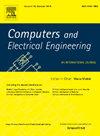Irradiance sensorless PSO-based Integral Backstepping and Immersion & invariance algorithm for robust MPPT control with real-climatic microcontroller-in-the-loop experimental validation
IF 4
3区 计算机科学
Q1 COMPUTER SCIENCE, HARDWARE & ARCHITECTURE
引用次数: 0
Abstract
This paper presents a novel irradiance sensorless Maximum Power Point Tracking (MPPT) controller for photovoltaic (PV) systems using a Particle Swarm Optimization (PSO)-based Integral Backstepping (IBSC) and Immersion & Invariance (I&I) algorithm. The proposed controller addresses the limitations of traditional and contemporary MPPT methods, such as the need for costly irradiance sensors and suboptimal performance under dynamic environmental conditions. The integration of a higher-order sliding mode differentiator (HOSMD) with the IBSC enhances transient response by completely eliminating overshoots, achieving a 0 % overshoot compared to 4.8 % with the conventional IBSC under standard test conditions. The system exhibits rapid tracking convergence with a significantly reduced tracking time of 0.4 ms, approximately seven times faster than the traditional Perturb and Observe (P&O) algorithm's 3 ms. Under real-world conditions, the proposed system's irradiance estimator maintains a mean absolute error below 15 W/m², with a maximum error of 69 W/m² at high irradiance levels. The system achieves an operating efficiency of 99.99 % with peak-to-peak power ripples of just 0.17 % under standard conditions, outperforming eight state-of-the-art MPPT techniques. This robust and efficient MPPT solution is validated through extensive simulations and real-climatic conditions. Additionally, real-climatic experimental implementations are carried out using Microcontroller-in-the-loop (MIL) integration. The acquired experimental results do not only corroborate the simulation outcomes but also endorses the reliability and practical robustness of the proposed MPPT controller
基于无辐照度传感器的pso积分反演和浸没不变性算法鲁棒MPPT控制与实时气候微控制器在环实验验证
本文提出了一种新型的无辐照度传感器光伏系统最大功率点跟踪(MPPT)控制器,该控制器采用基于粒子群优化(PSO)的积分反演(IBSC)和浸没法。不变性(I&;I)算法。提出的控制器解决了传统和现代MPPT方法的局限性,例如需要昂贵的辐照度传感器和动态环境条件下的次优性能。高阶滑模微分器(HOSMD)与IBSC的集成通过完全消除超调来增强瞬态响应,在标准测试条件下实现了0%的超调,而传统IBSC的超调率为4.8%。该系统具有快速的跟踪收敛性,跟踪时间显著缩短为0.4 ms,比传统的Perturb and Observe (P&;O)算法的3 ms快了大约7倍。在实际条件下,该系统的辐照度估计器的平均绝对误差保持在15 W/m²以下,在高辐照度水平下的最大误差为69 W/m²。在标准条件下,该系统的工作效率为99.99%,峰间功率波动仅为0.17%,优于8种最先进的MPPT技术。这种强大而高效的MPPT解决方案通过广泛的模拟和实际气候条件进行了验证。此外,利用微控制器在环(MIL)集成进行了实际气候实验实现。实验结果与仿真结果相吻合,验证了所提MPPT控制器的可靠性和鲁棒性
本文章由计算机程序翻译,如有差异,请以英文原文为准。
求助全文
约1分钟内获得全文
求助全文
来源期刊

Computers & Electrical Engineering
工程技术-工程:电子与电气
CiteScore
9.20
自引率
7.00%
发文量
661
审稿时长
47 days
期刊介绍:
The impact of computers has nowhere been more revolutionary than in electrical engineering. The design, analysis, and operation of electrical and electronic systems are now dominated by computers, a transformation that has been motivated by the natural ease of interface between computers and electrical systems, and the promise of spectacular improvements in speed and efficiency.
Published since 1973, Computers & Electrical Engineering provides rapid publication of topical research into the integration of computer technology and computational techniques with electrical and electronic systems. The journal publishes papers featuring novel implementations of computers and computational techniques in areas like signal and image processing, high-performance computing, parallel processing, and communications. Special attention will be paid to papers describing innovative architectures, algorithms, and software tools.
 求助内容:
求助内容: 应助结果提醒方式:
应助结果提醒方式:


